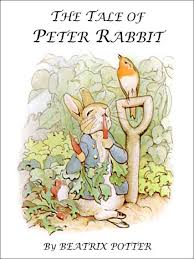
Beatrix Potter is known worldwide for her stories about Peter Rabbit, a young rabbit who lives in the country with his mother and his three sisters, Flopsy, Mopsy, and Cotton-Tail. They wear clothes upon occasion; and, although the rabbits live in a rabbit hole under a fir tree, their home has human amenities such as a kitchen and furniture. Beatrix Potter was taught at home by governesses, but she and her brother, Bertram, enjoyed having many small animals such as rabbits, birds, and mice in the schoolroom as pets. Potter loved to draw these small animals. In 1893 she wrote The Tale of Peter Rabbit with illustrations to send as a letter to the sick 5-year-old son of a former governess with the hope of cheering him up.
In the story Peter's mother instructs her bunny children to “go into the fields or down the lane, but don't go into Mr. McGregor's garden. Your father had an accident there; he was put in a pie by Mrs. McGregor.” Peter's three sisters run down the lane to pick blackberries while Peter,”who was very naughty, ran straight to Mr. McGregor's garden and squeezed under the gate.” Of course, Mr. McGregor finds the bunny gorging on his vegetables and tries to catch him. Peter manages to elude the angry Mr. McGregor and run home; but, sick from eating too many lettuces, beans, and radishes, Peter is sent straight to bed with a spoon of chamomile tea.
In 1902 Potter decided to publish “The Tale of Peter Rabbit” as a small book. Over the next 28 years she published 22 more little books in which anthropomorphic animals were the main characters. It is interesting that in books about animals that behave like people by speaking languages, wearing clothes, and living in human-like communities, there are usually other animals that do not act like humans. These animals are regarded simply as food by the animals that display human qualities. They do not wear clothes or speak languages, or live in human-like communities. However, those animals in the tale that are anthropomophized still often look upon other anthropomophized animals as potential dinner if they would normally be their prey in reality. Sometimes the fox in the chicken coop is Mr. Fox, a friendly neighbor that Miss Hen has invited over for tea. More often he is portrayed as a Dapper Dan more interested in having the unsuspecting Miss Hen for a tasty snack rather than dating her.
In the story Peter's mother instructs her bunny children to “go into the fields or down the lane, but don't go into Mr. McGregor's garden. Your father had an accident there; he was put in a pie by Mrs. McGregor.” Peter's three sisters run down the lane to pick blackberries while Peter,”who was very naughty, ran straight to Mr. McGregor's garden and squeezed under the gate.” Of course, Mr. McGregor finds the bunny gorging on his vegetables and tries to catch him. Peter manages to elude the angry Mr. McGregor and run home; but, sick from eating too many lettuces, beans, and radishes, Peter is sent straight to bed with a spoon of chamomile tea.
In 1902 Potter decided to publish “The Tale of Peter Rabbit” as a small book. Over the next 28 years she published 22 more little books in which anthropomorphic animals were the main characters. It is interesting that in books about animals that behave like people by speaking languages, wearing clothes, and living in human-like communities, there are usually other animals that do not act like humans. These animals are regarded simply as food by the animals that display human qualities. They do not wear clothes or speak languages, or live in human-like communities. However, those animals in the tale that are anthropomophized still often look upon other anthropomophized animals as potential dinner if they would normally be their prey in reality. Sometimes the fox in the chicken coop is Mr. Fox, a friendly neighbor that Miss Hen has invited over for tea. More often he is portrayed as a Dapper Dan more interested in having the unsuspecting Miss Hen for a tasty snack rather than dating her.
 RSS Feed
RSS Feed